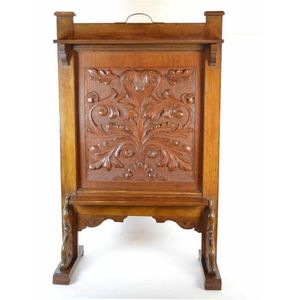William & Mary Burr Walnut Chest with Octagonal Legs
You must be a subscriber, and be logged in to view price and dealer details.
Subscribe Now to view actual auction price for this item
When you subscribe, you have the option of setting the currency in which to display prices to $Au, $US, $NZ or Stg.
- Burr - Burr (or in the USA, burl) is the timber from the knotted roots or deformed branch of the tree, which when cut, displays the small circular knots in various gradations of colour. It is always cut into a decorative veneer, most commonly seen as burr walnut on 19th century furniture.
- Octagonal Leg - Octagonal leg, also known as a faceted leg, is usually found on chairs and table pedestals made during the first thirty or forty years of the 19th century, though the design appears in some pattern books dating from the late 18th century. They are not uncommon on Australian colonial furniture of the period. The leg is turned, with the main body of the leg planed into a slightly tapering octagon between the upper and lower turnings. The leg was sometimes fluted or carved with foliage, although in colonial furniture it was more often plain. Octagonal legs are often found on elbow or carver chairs of the period, with scrolled arms sometimes known as Trafalgar chairs.
- Crossbanding - Crossbanding is a decorative technique used in furniture-making, where thin strips of wood, known as crossbands, are applied to the surface of a piece of furniture to create a decorative border or inlay. The crossbands are typically made of a different type of wood or a different color than the main piece of furniture, and are applied in a geometric pattern, such as a checkerboard or herringbone design.
Crossbanding was a popular decorative technique in furniture-making from the 17th to the 19th centuries, particularly in the Baroque, Rococo, and Chippendale styles. It was often used to create intricate patterns and designs on the surfaces of tables, desks, cabinets, and other pieces of furniture. The crossbands were often made of exotic woods, such as ebony or rosewood, which were imported from other parts of the world and were highly prized for their rich colors and patterns. - Bun Feet - Similar to ball feet, though somewhat compressed or flattened in appearance. Introduced during the late 17th century, but they have been used on furniture up to the present day.
This item has been included into following indexes:
Visually similar items

A fine William and Mary oyster veneered walnut chest on stand, the stand probably 19th century, 142 cm high, 102 cm wide, 59 cm deep

A William and Mary provincial oak chest on stand, 149 cm high, 107 cm wide, 66 cm deep

A string inlaid and crossbanded satinwood demi-lune side cabinet, possibly by Edwards and Roberts of London, circa 1890, 107 cm high, 122 cm wide, 47 cm deep

A West Australian Arts & Crafts style jarrah and Sheoak fire screen, early 20th century school of William Howitt (1846-1928), probably by one of his students the central sheoak panel decorated with carved acanthus leaves and scroll motifs. Height 83 cm, wi
